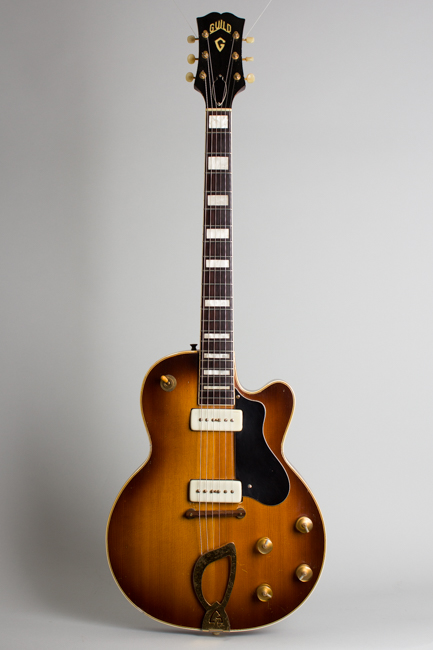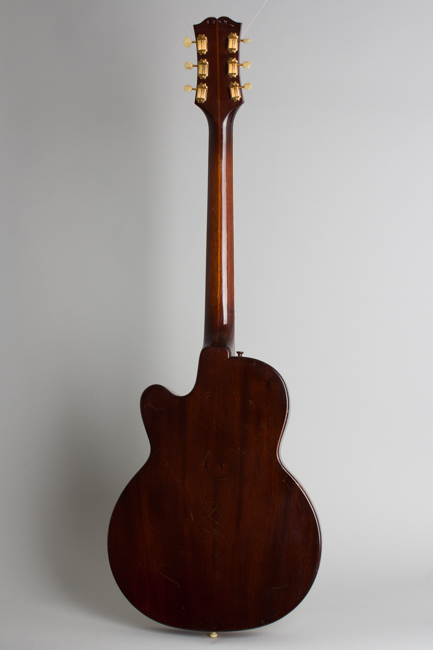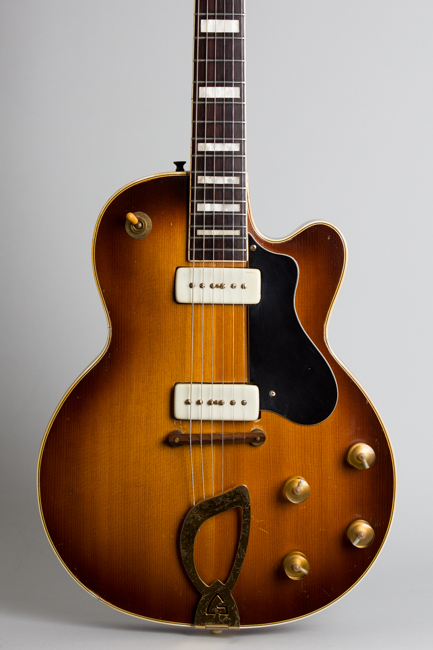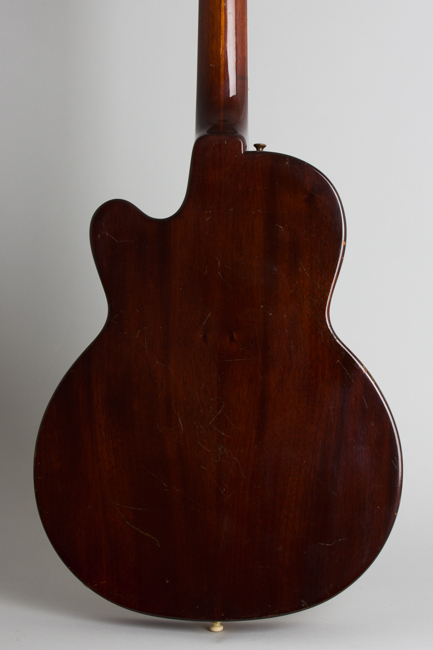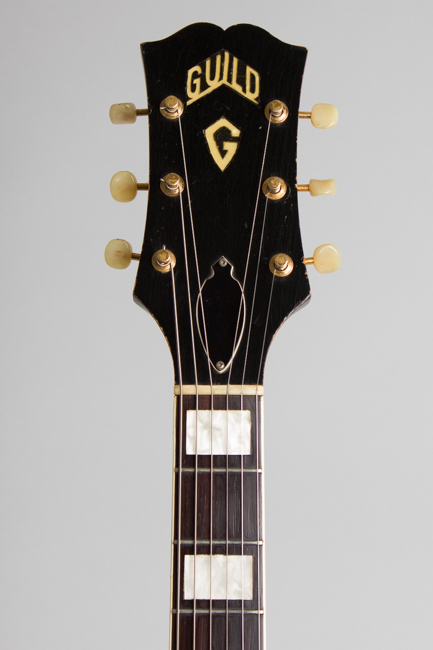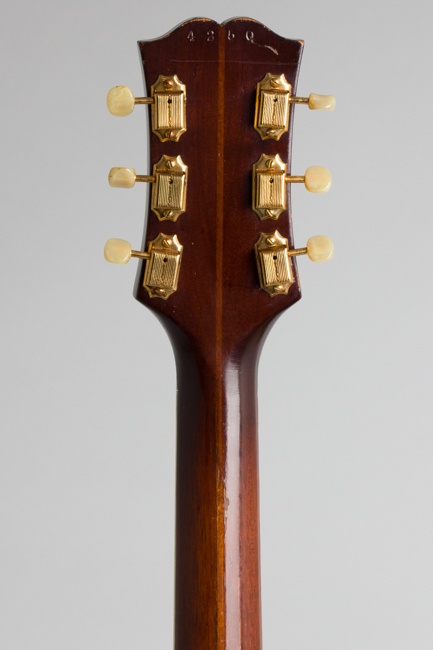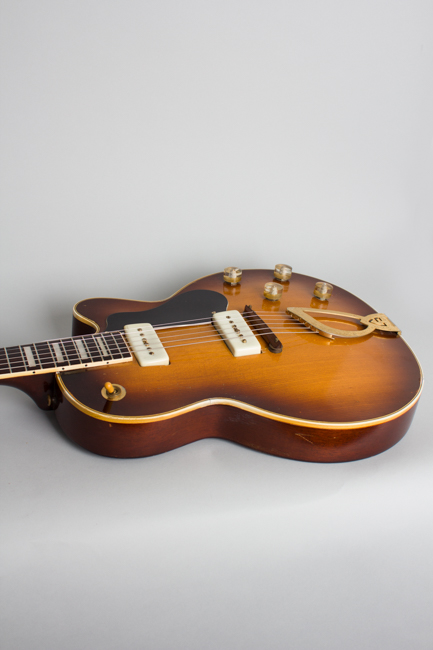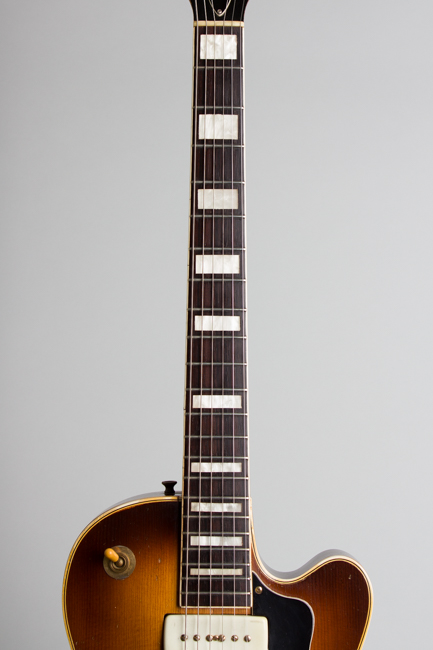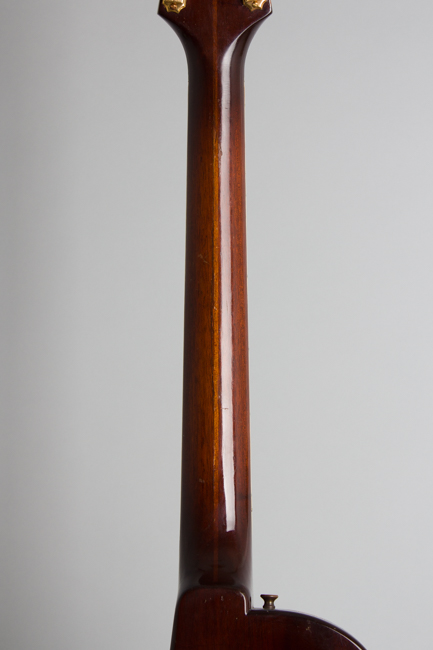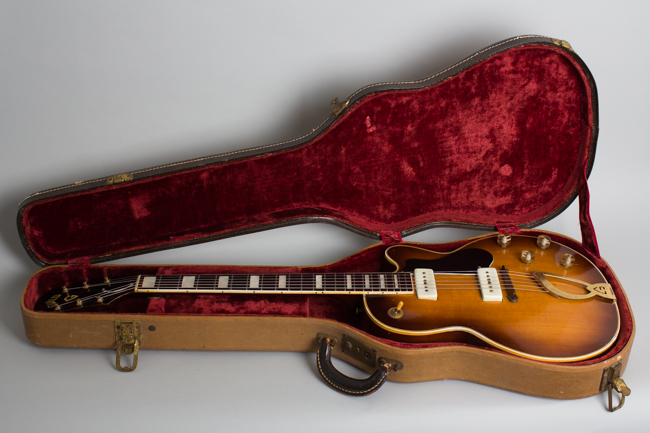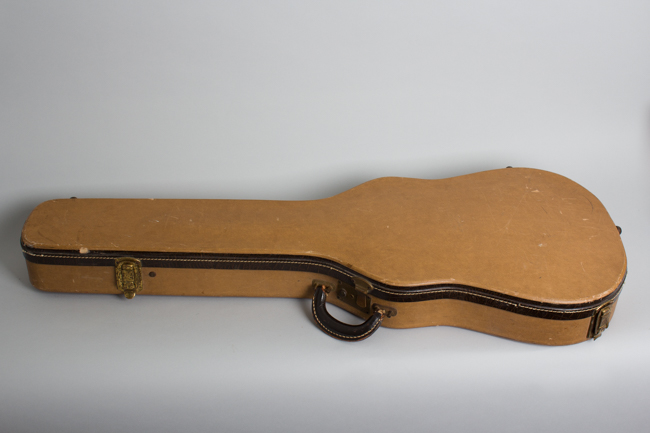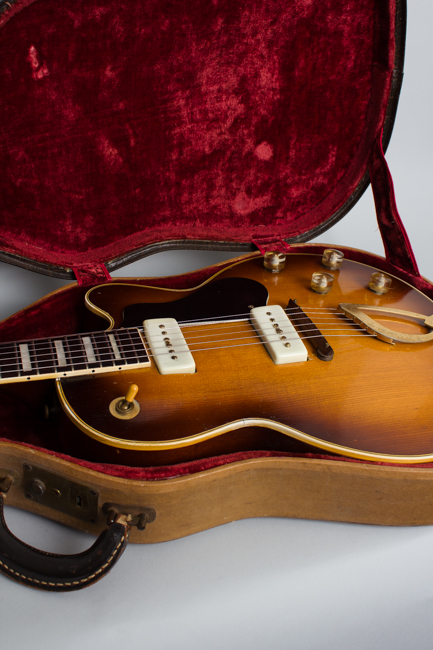Guild Aristocrat M-75 Thinline Hollow Body Electric Guitar (1957)
This item has been sold.
Item # 9870
Prices subject to change without notice.
Guild Aristocrat M-75 Model Thinline Hollow Body Electric Guitar (1957), made in Hoboken, NJ, sunburst top, dark back and sides finish, mahogany body, spruce top; laminated mahogany neck with rosewood fingerboard, original brown hard shell case.
Guild's M-75 is one of the company's most interesting original designs, their take on an idea that was kicking around New York in the early '50s -- a small semi-hollow electric guitar to compete with that new-fangled solid-body Les Paul from Gibson. Gretsch had come out with the Duo-Jet, a flashier take on the not-quite solid concept. At the time there seemed to be some resistance to the true solid-body in New York where many studio and broadcast performers worked. The archtop guitar was the preferred tool of most professionals, and the major NY-based builders -- Gretsch, Epiphone and Guild all eschewed actual solid-bodies in favor of this hybrid up into the next decade. While the M-75 looks somewhat like a Les Paul, it is much lighter with a more traditional archtop-flavored sound.
In the 1950's Guild sold an extensive line of full-sized archtop electrics, but the M-75 and its down-market sister the M-65 were arguably their most modern and distinctive offerings. Introduced in 1954 the "Aristocrat" is a classy little guitar, with higher end touches like gold plated hardware and block inlay on the bound fingerboard. The top is laminated spruce without soundholes, set over a mostly routed-out mahogany body. This gives the M-75 more of an acoustic tone quality than the Gretsch Jet series guitars that have more internal blocking.
The two pickups look like Gibson "soapbar" P-90's but were made by Fransch electronics in Woodside (Queens) NY, branded Franz. These units were standard on most 1950's Guilds; they have a lower output but a sweet and clear, somewhat microphonic response and add to the M-75's more acoustic character. The fairly slim and comfortable neck is mahogany with a laminated center strip and a bound rosewood fingerboard inlaid with pearloid blocks. The tuners are gold-plated individual Kluson Deluxe with the translucent plastic buttons specific to this model.
This 1957 M-75 has features specific to that decade; the knobs are small clear ambered style without numbers and the pickguard and small truss rod cover are typical 1950s Guild fittings. The headstock features a "Guild" inlay and a fairly crude version of their "G-Shield' symbol.
The M-75 was an under-appreciated instrument in its day, and never achieved the recognition it deserved. Players are often amazed at what a versatile and comfortable guitar this is. While not as much of a straight rock instrument as the Les Paul, and other solidbodies, it handles effortlessly and feels like nothing else. More than 60 years on The Aristocrat endures as a still-unique design and one of the original Guild company's finest moments.
Overall length is 39 1/4 in. (99.7 cm.), 13 5/8 in. (34.6 cm.) wide at lower bout, and 2 1/8 in. (5.4 cm.) in depth, measured at side of rim. Scale length is 24 1/2 in. (622 mm.). Width of nut is 1 5/8 in. (41 mm.).
This guitar has some fairly light wear and minor repair but overall is one of the nicer examples of this fairly rare model we have seen recently. It retains the original finish and hardware with just some typical maintenance work over the years. The binding -- which is often deteriorating badly on 1950s Guilds -- has several small repaired splits but is original and overall still intact with no badly shrunken or crumbling areas. There is checking to the top finish and headstock and small dings, scrapes and dents overall, mostly on the back.
With the exception of a repro switch tip all hardware appears original, including the rare but original gold-plated metal ring around the switch itself. The white plastic pickup covers have shrunken up a bit but not to the detriment of the pickups themselves, which still sound great. The wooden bridge saddle has had the wings undercut a bit to allow lower action settings. The frets are original; they have been polished down somewhat but have little subsequent wear and still play well. This guitar plays and sounds excellent with a low, fast action and still resides in a well-preserved original two-tone hard shell case. Overall Excellent - Condition.
Guild's M-75 is one of the company's most interesting original designs, their take on an idea that was kicking around New York in the early '50s -- a small semi-hollow electric guitar to compete with that new-fangled solid-body Les Paul from Gibson. Gretsch had come out with the Duo-Jet, a flashier take on the not-quite solid concept. At the time there seemed to be some resistance to the true solid-body in New York where many studio and broadcast performers worked. The archtop guitar was the preferred tool of most professionals, and the major NY-based builders -- Gretsch, Epiphone and Guild all eschewed actual solid-bodies in favor of this hybrid up into the next decade. While the M-75 looks somewhat like a Les Paul, it is much lighter with a more traditional archtop-flavored sound.
In the 1950's Guild sold an extensive line of full-sized archtop electrics, but the M-75 and its down-market sister the M-65 were arguably their most modern and distinctive offerings. Introduced in 1954 the "Aristocrat" is a classy little guitar, with higher end touches like gold plated hardware and block inlay on the bound fingerboard. The top is laminated spruce without soundholes, set over a mostly routed-out mahogany body. This gives the M-75 more of an acoustic tone quality than the Gretsch Jet series guitars that have more internal blocking.
The two pickups look like Gibson "soapbar" P-90's but were made by Fransch electronics in Woodside (Queens) NY, branded Franz. These units were standard on most 1950's Guilds; they have a lower output but a sweet and clear, somewhat microphonic response and add to the M-75's more acoustic character. The fairly slim and comfortable neck is mahogany with a laminated center strip and a bound rosewood fingerboard inlaid with pearloid blocks. The tuners are gold-plated individual Kluson Deluxe with the translucent plastic buttons specific to this model.
This 1957 M-75 has features specific to that decade; the knobs are small clear ambered style without numbers and the pickguard and small truss rod cover are typical 1950s Guild fittings. The headstock features a "Guild" inlay and a fairly crude version of their "G-Shield' symbol.
The M-75 was an under-appreciated instrument in its day, and never achieved the recognition it deserved. Players are often amazed at what a versatile and comfortable guitar this is. While not as much of a straight rock instrument as the Les Paul, and other solidbodies, it handles effortlessly and feels like nothing else. More than 60 years on The Aristocrat endures as a still-unique design and one of the original Guild company's finest moments.
Overall length is 39 1/4 in. (99.7 cm.), 13 5/8 in. (34.6 cm.) wide at lower bout, and 2 1/8 in. (5.4 cm.) in depth, measured at side of rim. Scale length is 24 1/2 in. (622 mm.). Width of nut is 1 5/8 in. (41 mm.).
This guitar has some fairly light wear and minor repair but overall is one of the nicer examples of this fairly rare model we have seen recently. It retains the original finish and hardware with just some typical maintenance work over the years. The binding -- which is often deteriorating badly on 1950s Guilds -- has several small repaired splits but is original and overall still intact with no badly shrunken or crumbling areas. There is checking to the top finish and headstock and small dings, scrapes and dents overall, mostly on the back.
With the exception of a repro switch tip all hardware appears original, including the rare but original gold-plated metal ring around the switch itself. The white plastic pickup covers have shrunken up a bit but not to the detriment of the pickups themselves, which still sound great. The wooden bridge saddle has had the wings undercut a bit to allow lower action settings. The frets are original; they have been polished down somewhat but have little subsequent wear and still play well. This guitar plays and sounds excellent with a low, fast action and still resides in a well-preserved original two-tone hard shell case. Overall Excellent - Condition.
